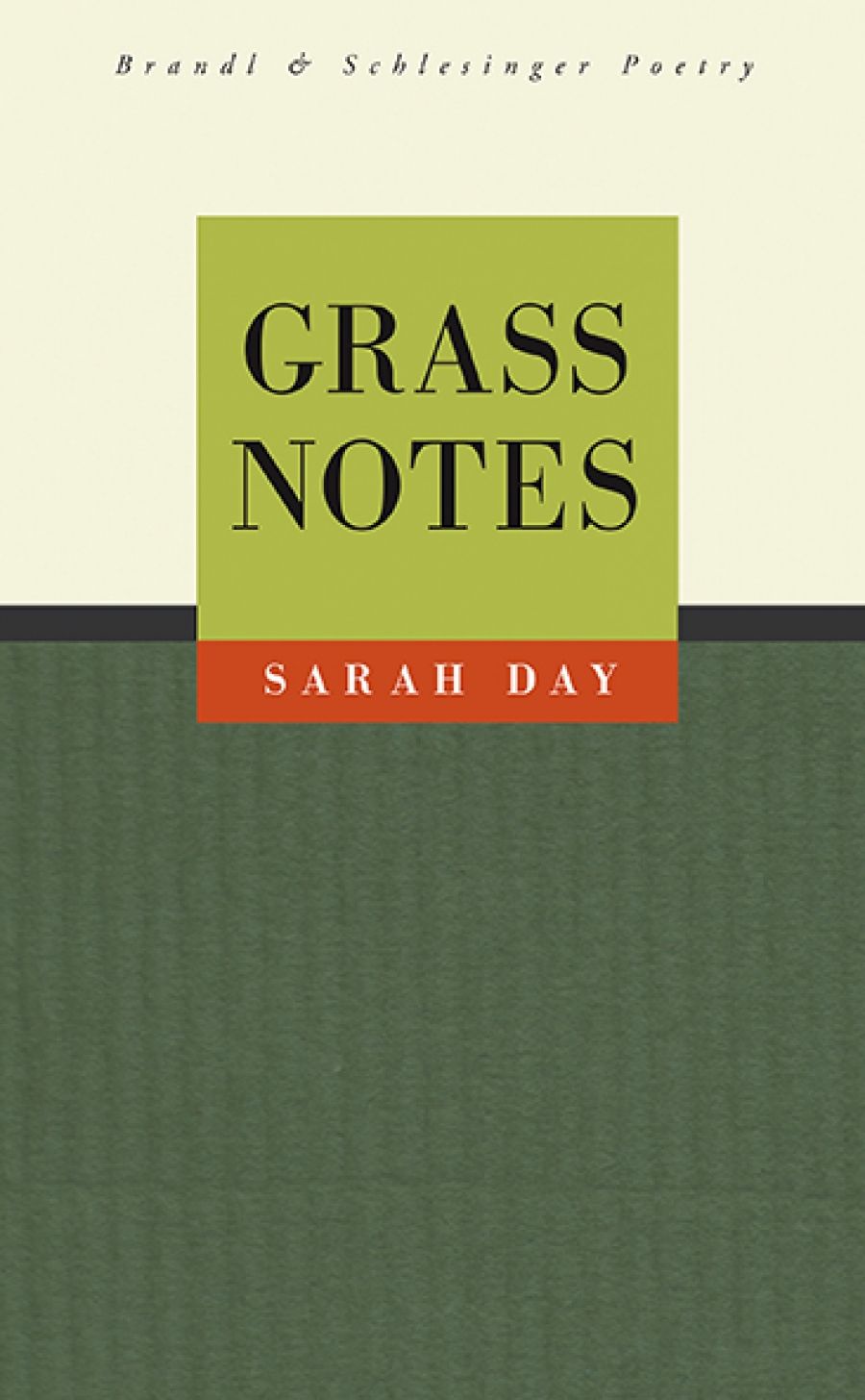
- Free Article: No
- Contents Category: Poetry
- Review Article: Yes
- Online Only: No
- Custom Highlight Text:
The subtle beauty of the title of Sarah Day’s new collection of poetry, Grass Notes, epitomises the lightness of touch and intensity that characterises the poems. This is a collection of observing what might otherwise be seen as slight or glancing, yet that offers powerful prisms of insight. In a Whitmanesque mode, Day’s perspective not only looks up from the grass into the vastness of the world, but also looks at the grass itself, the unexceptional yet foundational ground of all perception and experience. Perhaps as the poet scribbles ‘notes’ in that grass, there is also an echo of Wordsworth and post-romantics such as Judith Wright or Mary Oliver. The title also chimes homophonically with the idea of the musical ‘grace note’, that small, quick, note that runs into the next and, in its delicacy, makes that central sound, or image, both more appealing and more complex. In Day’s work, it is the delicacy of such lateral images, often derived from close consideration of the natural world, that complicates and enriches the ideas at work within the poems.
- Book 1 Title: Grass Notes
- Book 1 Biblio: Brandl and Schlesinger, $24.95 pb, 74 pp
In ‘Observatory’, the gaze travels from the immediate natural world of the speaker to the broad canvas of infinity: ‘The rattle of wind in sclerophyll / is the murmur of cosmic dust / and particle shift.’ Not only does the poet’s eye look intently into rich unknowability, but the poem also stresses that the process of looking is two-way: ‘Through a fish-eye lens / the universe gazes back / into the great eye of humanity.’ The speaker, at one end of the massive telescope, is both singular and collective, and becomes herself an object of consideration. Both particular and humble, she is ‘orbiting a mundane star on the outer margins / of the Milky Way, one stella cluster / among the infinite’. Even as the poetry focuses our attention on the world – the specificities of rain, two unhappy polar bears in an enclosure, the intense identification of a cat watching a bird – Day crucially turns poetry’s telescope back on the speaker and indeed the reader, the one exhorted to watch and learn.
In the poem ‘Finding North’, Day identifies the question central to the writing of lyric poetry: the relation of the particular image to broader questions of history, politics, ethics. ‘What does an elderly woman / towing a child, a small boy, / in an inflatable boat, / through shallow water / tell me about history?’ she asks. Is the poetic a distraction to these so-called serious questions, or can the clarity of such an image prise open a rigid and compartmentalised way of seeing and understanding the world helping us find a true north? As Day notes in ‘Present Time’, it is the specificity of the image that offers the transformative vision of the ‘present moment [which] saturates all given form / with past and future’. It is the image – observed, crafted, re-presented – which allows us to look again, offering another chance to see the world more clearly, as well as the complexity of our place within it.
The series of short poems eponymously titled ‘Grass Notes’ explicitly uses the power of the image to provide an unsettling view of colonial Australia. ‘Presentiment’ looks for the moment of incipient change as it might have been perceived from the point of view of an indigenous continent, immediately before first contact: ‘the bark of a dog / in the eucalypt air, / the marsupial faces tilted, listening’, or the ‘speck on the broad Southern Ocean / observed from afar through a squint of unease’. ‘Notes on a Watercolour’ admires the work of ‘Miss Cleburne’s “View on the River Derwent” c. 1870’, who ‘made no concession / to nostalgia’s green longing’ – and yet who omits a world and a history which her colonial eye perhaps ‘saw or did not own to seeing’.
‘Cemetery’, much like Wright’s early ‘Nigger’s Leap, New England’, wonders at the haunting of such settlers, however well intentioned, by what lies outside the fragile boundaries of the regimented graveyard, ‘the lamentations / in the soughing she-oaks, the sorrows / in the gentle waters of the channel’. ‘Mantrap 2008’ brings the unease into the present by offering an inventory of what is found in the ‘locked shed, like a family album’ – not only the accoutrements of nineteenth-century life, but the dawning horror of the ‘mantrap, mounted on an iron cross, / its cruel teeth clamped / to hair’s-breadth precision’. Just as Kate Grenville’s The Secret River depicts the cost of a colonial success built upon dispossession, so too does ‘Grass Notes’ implicate both the speaker and the reader in this violent history. In ‘Nest’, Day envisions this through the image of the tiny bird nest, with its telltale scraps of colonial life and its legacies. There is ‘a colonial history / cupped in the substance / of this little vessel’, its weave of wallaby grasses a shadow of the women ‘to whom this pasture / once was home.’
There is beauty here, but there is also the bass note of a brutal past and the complex position of the post-colonial poet who has inherited this difficult history, and who loves the very grass of the Australian landscape as much as Miss Cleburne did, and the lost Aboriginal woman who wove those grasses into baskets of beauty and usefulness.

Comments powered by CComment